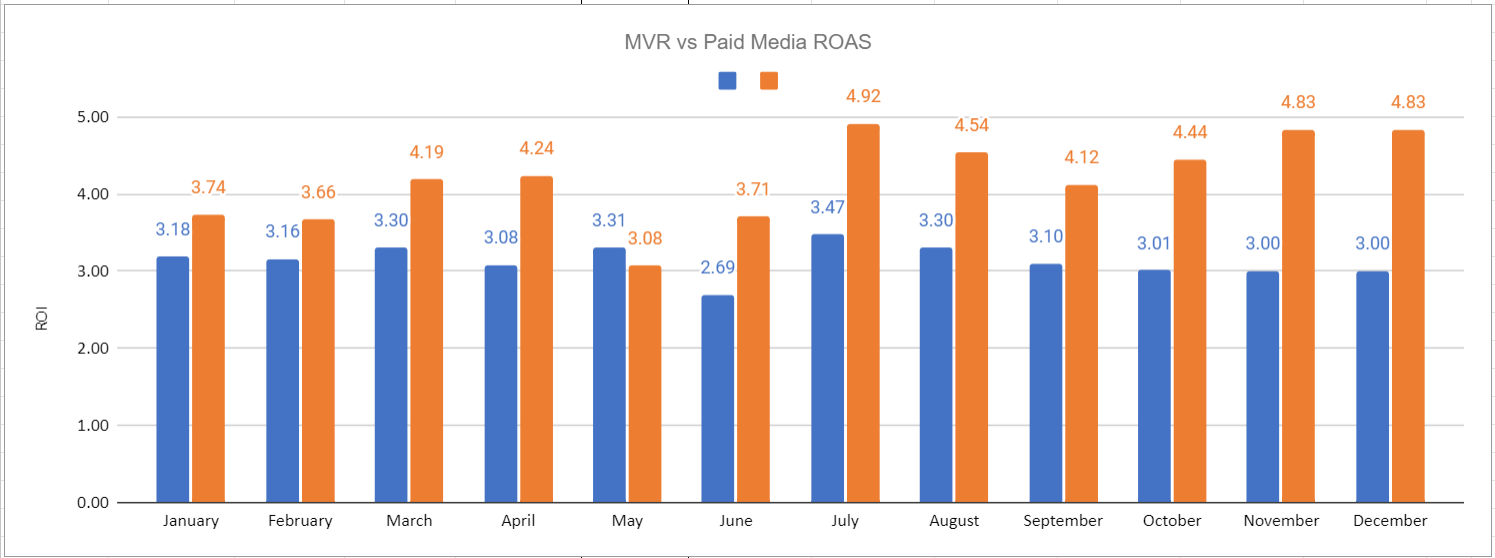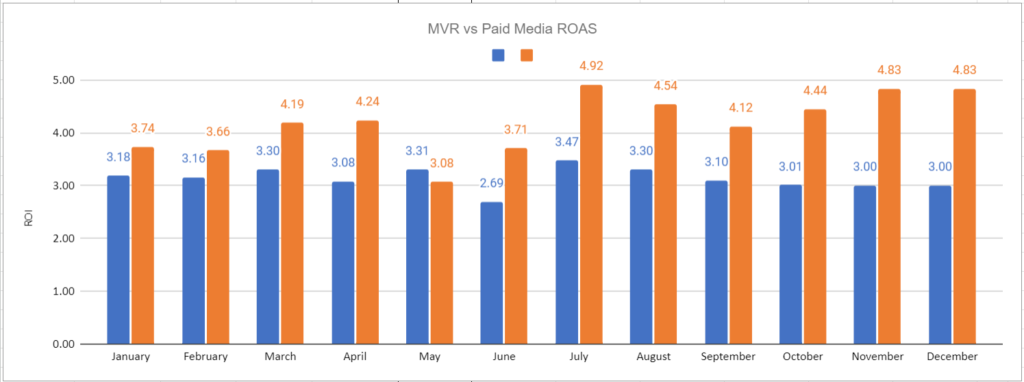Using Marketing Efficiency Ratio (MER) To Scale Your Business

What is Marketing Efficiency Ratio?
Marketing efficiency ratio (also known as MER) is a relatively new term for a traditional way of monitoring the Return On Investment (ROI) of your businesses marketing budget. As well as monitoring marketing channels individually, MER looks at all marketing expenditure and all revenue taken through the business. In a way this is a much more simplified and traditional way of looking at marketing spend as it can be as simple as money in money out. This can help you scale your business growth much quicker than looking at channels at a more granular level.
The History Of Marketing Attribution
To understand the need for MER we need to look back at the past 20 years of marketing attribution. Over the past two decades multiple ad platforms have taken off with incredible success –
- Google Ads
- Meta Business Ads
- Amazon
- Microsoft Advertising
- TikTok Ads
- Pinterest Ads
- Twitter Ads
- Linkedin Ads
The list can go on and on. Each of these platforms has its own interface, conversion tracking and attribution window. They each try their best to track sales back to user activity for more accurate tracking. All this is great, but it’s a very difficult job to track people across multiple devices and email accounts. This means your marketing channel attribution will always have holes in it and will be driving sales that aren’t always attributed back to the original source.
How Does MER Help?
MER looks at all marketing spend and all business revenue. So, if you know your business is happy with Return On Marketing Investment (ROMI) of x4.0 then your MER can be the same. e.g. with a marketing budget of £100k you would be looking for a MER of x4.0 which would equate to £400k in revenue.
This simple calculation can help you be more aggressive with your marketing budget instead of fixating on micro level attribution figures which can sometimes stifle marketing spend and business growth.
Is MER That Simple?
Well, not really. The trick in using MER to scale a business is to work out the relationship between your marketing budget and revenue growth through other channels such as Organic Search and Direct to site.
When you advertise your brand on paid media channels you are growing your brand. Some of the audiences you target will buy through the channel you used to advertise to them, but not all. Some people will become aware of your brand and will come back through other channels such as Organic Search or Direct to site, or in some cases they may come back on a different device such as a work computer or partner’s phone. This is often overlooked and the paid media channel doesn’t get any credit for these sales. The argument is often ‘we would have got those sales anyway’ which has some truth to it but how did these people first hear about your brand? Often, very little other marketing is happening so there’s a good chance that your paid advertising played some part at some point.
Understanding The Relationship Between Marketing Channels
To understand relationships between marketing channels I create my clients a Google Sheet which tracks the following by month –
- Paid media spend split by channel
- Revenue from each paid media channel (from their platform e.g. Google Ads)
- Total website revenue (From either Google Analytics, website data or internal business data)
- ROAS from each paid media channels (conversion value / cost)
- Overall MER (all online revenue / marketing cost)
Now the complicated bit. I then use calculations to calculate the following –
- Revenue from ‘other channels’ this includes all channels that are not receiving marketing budget
- The percentage of revenue from ‘other channels’
As I populate this data overtime I can start to see trends and answer certain questions e.g.
- If paid media spend is increased by 20% what effect does that have on revenue from other channels (such as Organic Search and Direct to site).
- If paid media spend is increased by 50% does the revenue from other channels increase by the same amount

This data can build confidence to increase budgets of paid media channels or investment in SEO as you know other channels will follow suit. The other great benefit mapping out this data and noticing trends is that you can also start to predict how the next year will pan out. This can be incredibly important for budgeting or securing investment for your business which can lead to further growth.
If you would like me to implement an MER analysis to your business then please get in touch.
How does Marketing Efficiency Ratio (MER) differ from Return On Ad Spend (ROAS) metrics in terms of measuring marketing effectiveness?
Marketing Efficiency Ratio (MER) offers a different perspective compared to traditional Return On Ad Spend (ROAS) metrics by focusing on a simplified approach to monitoring the effectiveness of marketing budgets. While ROAS typically evaluates the performance of individual marketing channels, MER tracks all marketing spend and total revenue generated by the business. This allows for a more simplified view of marketing efficiency and more clearly shows the relationship between overall marketing investment and revenue.
Can MER accurately account for the impact of brand awareness and indirect conversions from paid media channels on overall revenue growth?
MER helps with the understanding of marketing beyond direct conversions from paid media channels. It acknowledges that advertising campaigns not only drive immediate sales but also contribute to brand awareness and customer acquisition through other channels such as Organic Search and Direct to site. Accurately attributing these indirect conversions poses a challenge, as tracking user behaviour across multiple devices and touchpoints remains complex. Despite these limitations, MER aims to capture the overall value generated by marketing activities, including both direct and indirect contributions to revenue.
What are the challenges and complexities involved in implementing MER analysis, especially in tracking relationships between various marketing channels and attributing revenue accurately?
MER analysis involves navigating various challenges, especially in tracking relationships between different marketing channels and accurately attributing revenue. One issue is distinguishing between the effects of paid media spend and the organic growth of other channels. For example, increasing the budget for paid media channels may lead to a rise in revenue from Organic Search and Direct to site, but calculating the exact impact requires careful analysis. Predicting future trends and budgeting based on MER data demands a thorough understanding of historical patterns. Despite these challenges, MER insights can provide valuable insight for optimising marketing strategies and business growth.